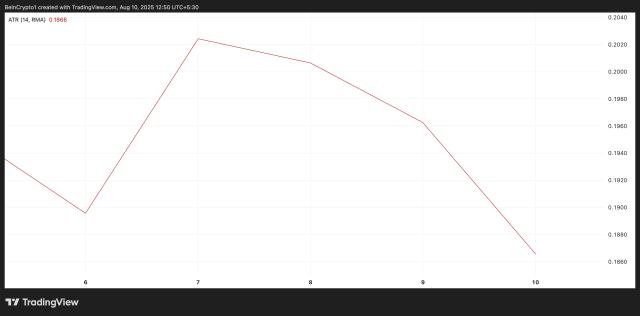MicroStrategy's logic is simple and brutal. Issuing debt to buy Bitcoin, betting that the coin price will rise to cover the interest. However, the efficiency of this model is rapidly declining. In 2021, MicroStrategy could generate one basis point of return for shareholders with every 12.44 BTC. By July 2025, it would require 62.88 BTC to achieve the same effect. The scale has expanded fivefold, but the efficiency has dropped to one-fifth.
In contrast, The Ether Machine takes a different path. Through staking and DeFi participation, ETH generates approximately 5% annual cash flow daily. No need to wait for price appreciation or pray for a bull market—this is tangible income, not paper wealth.
The fundamental difference lies in the asset properties: Bitcoin is digital gold, with its value derived from scarcity and consensus. Ethereum, on the other hand, is digital infrastructure, with its value stemming from its ability to support the entire ecosystem's operation.
We can now trace back the history from the MicroStrategy era and discover that we are experiencing the third stage of evolution towards crypto treasuries:
Stage One: Pioneer Dividend Period (2020-2023) At the time, the overlooked MicroStrategy proved that listed companies could obtain a premium by holding crypto assets.
Stage Two: Model Replication Period (2024-2025) Successful imitators emerged. SharpLink's stock price surged 4000% before plummeting 70%. Marathon Digital and Riot Platforms followed suit, but with poor results, exposing the risks of simple asset hoarding.
Stage Three: Model Evolution Period (2025-) Represented by The Ether Machine—not accumulating assets, but operating them to create diversified income sources.
However, achieving this evolution from asset hoarding to asset operation is far from easy. It requires not only a profound understanding of the crypto world but also experience in navigating the traditional financial compliance maze.
4 Key Operators Behind the Behemoth
The "Ethereum Avengers"—when The Ether Machine's chairman describes the team with this term, it is no jest. These "avengers" with deep backgrounds are attempting to reshape the landscape of institutional crypto investment.
The story begins in ConsenSys, the "crucible" of the Ethereum ecosystem. It was there that Andrew Keys and David Merin first met. At the time, they could not have anticipated their deep connection with top global financial institutions.
In 2017, during the "crypto winter" after the ICO bubble burst, the entire industry was permeated with despair. At a time when everyone was fleeing, Andrew Keys was determined to knock on Microsoft and JPMorgan's doors with Ethereum.
"They looked at Andrew Keys as if he were a madman selling a perpetual motion machine."
But he did not give up. Repeated rejections, repeated explanations, until skepticism slowly turned to curiosity. Eventually, he founded the Enterprise Ethereum Alliance (EEA), bringing the word "Ethereum" into the conference rooms of the world's top 500 companies for the first time.
Meanwhile, David Merin drove business transformation within ConsenSys, leading over $700 million in financing and acquisitions.
In countless late-night discussions, they realized that between traditional finance and the crypto world lay not just prejudice, but a tangible compliance gap.
"Numerous institutions are interested in Ethereum, but ultimately stop short due to a lack of credible investment tools."
This pain point prompted them to make a bold decision: no longer just being "evangelists," but personally stepping in to create a regulated financial vehicle.
Keys' first move shocked everyone—he used his personal ETH worth over $600 million as initial investment. "If I don't believe in it myself, how can I make others believe?"
His all-in stance showed his determination. In a later CNBC interview, he explicitly stated: "I'd rather have an iPhone than a landline." This analogy perfectly explained why he was betting solely on Ethereum.
The team then began to assemble. They found Darius Przydzial, a "double agent" who had managed traditional risks at Fortress and was a core contributor to the DeFi protocol Synthetix. His task was clear: to strike gold in DeFi's wild west while keeping himself alive.
To ensure technical security, Tim Lowe, with twenty years of bank-level system experience, joined the team. Finally, the arrival of Jonathan Christodoro, a PayPal director and former Icahn Capital executive, provided the ultimate endorsement for the company's governance structure.
The team's internal path was not smooth. The traditional finance faction advocated conservatism, while the crypto-native faction leaned towards radical innovation. After countless unproductive meeting debates, Keys decisively concluded: "We're not choosing sides, but becoming the bridge connecting both."
This sentence became The Ether Machine's unchanging core philosophy.
Vitalik's Call: We Should Not Pursue Large Institutional Capital at Full Speed
If the idealism represented by the Ethereum Foundation, centered on technology and community, constituted ETH's first lifeline, what we are witnessing now is its natural evolution and handover: as EF gives way to capital, ETH's second lifeline has already begun.
This new lifeline may not deviate from the original intention, but it will undoubtedly lead Ethereum into more complex deep waters. The question is, in this process, what will Ethereum become? What risks will it face?
The foremost is technical risk: smart contract vulnerabilities, staking penalties could lead to 100% ETH loss, and with a weeks-long unlock period, liquidity becomes a luxury. When a single entity controls a large amount of ETH, are we strengthening Ethereum or changing its essence?
Subsequently, community opinions showed clear divergence. A comment by @azuroprotocol precisely captured this anxiety: from "building a decentralized Ethereum" to "selling 40,000 ETH to enterprises," ultimately evolving into "Web3 becoming Wall Street 2.0".
Even Vitalik has issued a warning: "We should not pursue large institutional capital at full speed." Now, with 70% of staked ETH concentrated in a few pools, is his concern becoming reality?
Meanwhile, "@agentic_t" bluntly exposed the community's core dilemma: "When prices rise, who cares about decentralization?" The 4%-5.5% staking yield seems attractive, but history tells us that all excess returns will eventually be arbitraged away.
Similarly, although Keys believes Ethereum has become the biggest beneficiary of the GENIUS Act, and the regulatory spring seems to have arrived, what comes after spring? When policy winds shift, might these institutionalization efforts become regulatory targets?
A Sign of Maturity or the End of Ideals?
Perhaps every successful technology ultimately moves towards institutionalization. The internet, mobile payments, and social media have all gone through this process.
As Ethereum transitions from idealists' experiment to an investment product for Wall Street, is this a sign of maturity or a departure from its original intention?
Time will provide the answer.
Disclaimer: As a blockchain information platform, the articles published on this site represent only the personal views of the authors and guests, and are unrelated to Web3Caff's stance. The information in the articles is for reference only and does not constitute any investment advice or offer. Please comply with the relevant laws and regulations of your country or region.
Welcome to join the Web3Caff official community: X(Twitter) Account | Web3Caff Research X(Twitter) Account | WeChat Reader Group | WeChat Official Account







